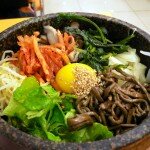Nutrition Info: Calories in Bibimbap
Posted on | April 17, 2013 | No Comments
Bibimbap in Korean translates to “mixed rice” and is easily described as a bowl of warm white rice topped with vegetables (thin slices of cucumber, zucchini, mushrooms, spinach, sprouts , lettuce), egg (raw or fried), sliced meat (beef or chicken) , chilli and kimchi.
One variation of this dish can be served in a hot stone that has sesame oil in the bottom, rice, vegetables and a raw egg that is mixed through and cooked whilst stirring in the heat. In some parts of Korea raw seafood is also used.
I believe the preparation of this dish greatly affects the calories. If the portion is small, with no oil, no fried egg, then it will be around 400-500 calories. However, if you consume a larger portion, that’s very oily, then it’s correct to estimate approximately 650 calories. (REMEMBER: Every chef is different: calories depend on portion, ingredients and preparation! This is why when you look online, you will see such varying search results)
(I must admit, on the 3 times I’ve eaten Bibimbap, I’ve been disappointed. The picture on the menu looks healthy and fresh, but then the real meal I’ve been served is spitting oil in my face, has a fried egg and leaves me wishing I’d wasted my calories on something nicer. Perhaps this is a challenge to find a healthy home recipe to change my opinion)
Calories in Bibimbap: 1 bowl serve
- Energy: 560 Calories
- Protein: 18g
- Carbs: 89g
- Fat: 15g
I believe this meal has the potential to be healthy, and in Korea, it probably is (even in Korean restaurants in other countries it would be served fresher) – however the versions sold in hawker stalls in Singapore is somewhat oily.
To make this meal healthier choose a fresh egg, you could ask for less oil and if you could find an option that is served in a bowl (not fried on a hotplate) it would reduce the calories per serving.
At the very least, try to always remember my advice: Eat slowly, put your eating utensils down inbetween bites and stop eating when you feel 80% full because it’s better to waste it than to ‘waist’ it.
Enjoy!
Visit www.healthguru.sg for further healthy eating tips.
Photo credit: www.hancinema.net
Tags: Calories in Bibimbap > Calories in Korean food
Comments
Leave a Reply
You must be logged in to post a comment.




